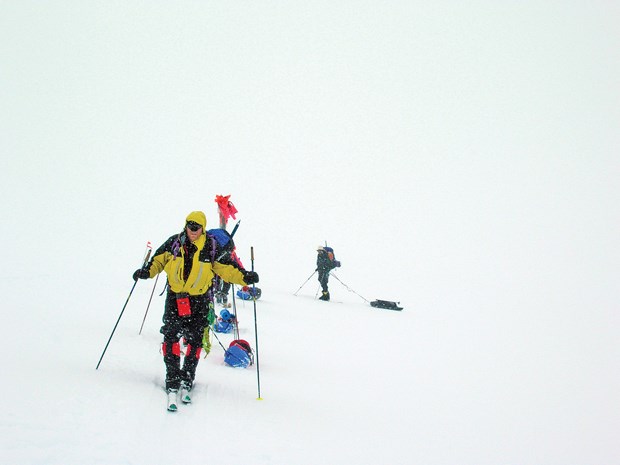He was somewhere around 18,000 feet above sea level when his thoughts drifted from spaghetti and meatballs to death.
Erik Bjarnason had been excited at the prospect of heading to the Yukon to celebrate the 40th anniversary of North Shore Rescue with a five-week trek to Canada’s highest peak: Mount Logan.
The isolated mountain is about two-thirds the height of Everest. Jagged pillars of ice stretch 100 feet into the sky and temperatures dip to -50 C.
Bjarnason was looking forward to it.
In his new book, Surviving Logan, the North Vancouver firefighter describes in painful detail the trip that claimed his fingers and very nearly took his life.
Discussing a childhood spent on Dempsey Road, Bjarnason recalls the Christmas parties that would unite his Icelandic family, including Uncle Greig.
Despite being a world traveller and founding member of NSR in 1965, back when part of the team’s mandate was to offer assistance in case the Soviets attacked, Bjarnason’s uncle was “quite tight-lipped” about his exploits, Bjarnason notes.
But on Christmas, that would change.
“Of course he’d have a couple pints and that would loosen up the lips and he’d actually tell the stories,” he recalls. “I remember just sitting there in awe listening to him talk about saving these people and jumping out of helicopters and bringing people back to their families and I thought, ‘That’s something that I’d really, really like to do.’”
From the time he was in Grade 6, before the invention of the helicopter parent, Bjarnason would head off into the woods and camp.
“It was a wonderful childhood.”
By the time he ventured to the Yukon in 2005 he’d breathed the rarified air of the Andes in South America and summited Denali in Alaska.
“I like being far from civilization,” he explains in the book. “It connects me to Earth and grounds me like nothing else.”
For Logan, he travelled with an Olympic athlete and future NSR team leader Mike Danks (“I liked the kid,” he notes of Danks).
The way up the mountain was slow, as a snowstorm confined Bjarnason to a tent where the major priority was to clear snow off the tent and urinate in the bottles with the skull and crossbones and easily distinguishable from their drinking water.
With his ascent stalled, Bjarnason turns inward.
“The mountains are in my blood,” he writes. “I couldn’t give it up any more than I could give up breathing.”
But that pursuit comes with a cost as his marriage crumbles – due in part to his propensity for walking away from civilization and pursuing what he regards as a selfish but inescapable passion.
His own guilt becomes a small “but certainly discernible” part of the expedition.
One of the book’s most emotionally fraught moments is when he tries to call his young children from the mountain and his ex-wife picks up the phone.
“To say that we did not have the best relationship at this stage is understating it,” he confides.
As the story unfolds, we become acutely aware of Bjarnason’s hands.
At a moment when everything’s going right, Bjarnason lends out his pair of fleece mitts.
A little later, when a cyclone lashes Bjarnason and his fellow climber to a ridge, he takes off a couple of his gloves to prep the stove and a blast of Arctic air blows them away.
“When you climb you’re making about 10,000 decisions a day, and any one of those decisions can end really, really badly,” Bjarnason explains. “We made some bad decisions and then, for a couple hours, everything went right. The sky’s parted, the helicopter was able to get to us. So in the end, we lived, so we must’ve made all the proper decisions.”
The book opens with a quote from another of Bjarnason’s uncles.
“Icelanders are all immortal right up to the second they die,” Uncle Don said.
Asked about his perspective more than 11 years after he thought he might die on a mountainside – and after he once suggested he might be better off dead on that mountainside – Bjarnason is grateful.
“I think I value life a bit more. Now I know it can be snuffed out at a moment’s notice so food tastes a bit better, beer’s a bit colder. I’m more grateful for everything around me,” he says. “Everything now is icing on the cake because there’s no way we should’ve lived through that experience.”
It took him awhile to reach that perspective. The book, written with Cathi Shaw, details the days when Bjarnason pondered a life spent watching TV, drinking, and collecting disability paycheques.
“I made a valiant effort to make sure that I continued on my proper path instead of falling down and basically crawling into a bottle and dying,” he says.
He returned to his job as a firefighter, and while he’s no longer in the field, he still assists NSR when they need him. He even went back to the mountains, scaling the tallest peak Europe had to offer.
Still, he remembers the one person he couldn’t save.
Bjarnason remembers a long talk he had with long-time NSR leader Tim Jones on the day Jones died.
“He saved my life and in his hour of need I was unable to return the favour,” he says. “I would’ve been so proud if I was part of the team that saved him that day.”
The book is dedicated to Jones.
A launch party for Surviving Logan is scheduled for Nov. 26 at the NSR centre at 61 Bewicke Ave.



